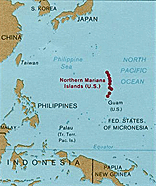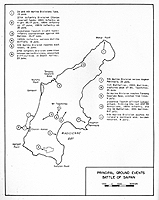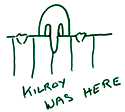| Join | Official Historian | City of Stamford | Blog | About Us | |
| Jewish Historical Society | Civil War Roundtable | Contact Us | |
|
|
|
|
The Stamford Historical Society PresentsPride and Patriotism: Stamford’s Role in World War II
|
 large map of Mariana Islands and Saipan |
The Battle of Saipan took place on the Island of Saipan, northernmost island of the Mariana Islands, between 15 June and 9 July 1944. The island is some 72 square miles in size and has a mountainous interior rising to the 1554 foot high, Mt. Tapotchau. The operational plan for Saipan was code-named Forager. The United States assault forces were made up of the 2nd and 4th Marine Divisions and the 27 Infantry Division, all under Lt. General Holland Smith, and Naval forces under Vice Admiral Richmond Kelly Turner. They faced the 43rd Division of the Imperial Japanese Army and a mixed brigade of the 47th Independents, some 31,000 troops strong, under Lt. General Yoshitsugu Saito, and Naval forces under Vice Admiral Chuichi Nagumo, the former victorious commander of the Mobile Fleet. Since his loss at Midway he had been demoted. Nagumo allowed Saito to lead the defense. The Japanese force was twice as big as the Americans believed it to be.
From late 1943 to early 1944 the Allied forces had captured the Solomon Islands, the Gilbert Islands, the Marshall Islands, and the Papuan peninsula of New Guinea. They now faced the line of Japanese defense in the Central Pacific: the Caroline Islands, the Palau Islands and the Marianas.
In the southwest Pacific, northern New Guinea and the Philippines were still Japanese-held. While General Douglas MacArthur continued his advance overland through New Guinea and Morotai toward the Philippines, Admiral Chester Nimitz continued the campaign of island hopping by attacking the Marianas. The Mariana’s value was increased by their viability as locations for airfields at which to base the B-29 Flying Fortresses. From the Marianas, these large bombers could hit Tokyo. The Japanese anticipated the attack, although they thought the thrust would come through the Caroline Islands. They initiated Operation A-Go to reinforce their garrisons and achieve naval and air superiority. It also provided for a carrier attack.
 large image of Principal Ground Events Battle of Saipan |
On 11 June Task Force 58 launched 225 planes to the southern Marianas and they destroyed between 150 and 215 planes. Navy strikes commenced thereafter.
On 13 June the U.S. Naval bombardment of Saipan began, 15 battleships were involved and over 165,000 shells were fired. On 15 June 1944 the landings commenced and by 9 AM over 300 LVTs (landing vehicles) had transported 8,000 Marines to the west coast of Saipan. Japanese artillery destroyed 20 amphibious tanks but, despite this, by the end of the day a beachhead 10 wide and one kilometer deep had been established. Some 2000 marines had been killed ,but 20,000 had been landed on the beach. The enemy forces counter-attacked at night with heavy losses. On 16 June the Army’s 27th Infantry Division landed and advanced on Aslito airfield. By 18 June Saito, the Japanese commander, abandoned the airfield. The Japanese had been surprised by both the target chosen for the assault, and the size of the attacking force. Yet, Admiral Toyoda Soemu, Commander in Chief of the Japanese Navy, believed the A-Go force could be used to attack U.S. Naval forces at Saipan. On 15 June the Japanese forces went into action but the Battle of the Philippine Sea was a disaster, with the Japanese losing three aircraft carriers and hundreds of planes. The battle also effectively stopped the Japanese ability to resupply their Marianas forces. Because of the Bushido Code, the Japanese defenders of Saipan were determined to fight to the death. Saito reorganized his defenses along a line anchored on Mt. Tapotchau in the mountainous region of central Saipan. Fighting was brutal and nicknames given to battle sites,: Hell’s Pocket, Purple Heart Ridge, Death Valley, indicate the experiences had by the combatants. The Japanese made ample use of the volcanic caves to hide themselves, but as the battle continued, the U.S. forces perfected ways of clearing the caves by using flame throwers and machine guns. Controversy erupted in the U.S. Forces when Marine General Holland “Howling Mad” Smith relieved the commander of the 27th Infantry Division, Army General Ralph C. Smith, because he was not satisfied with their performance. All the while Navaho code talkers played a key role in directing naval bombardments.
By 7 July the Japanese had no defensible position. Saito ordered a suicide charge of his remaining 3000 men, then killed himself. Many other Japanese committed suicide rather than surrender to the enemy, many jumping from “Suicide Cliff” or “Banzai Cliff.”
American casualties totaled 3500 killed and 13, 160 wounded. The Japanese losses totaled 21,000 killed in action, 8,000 suicides and 921 prisoners. After the battle Saipan became a key base for the invasion of the Philippines in October 1944, and the bombing of the Ryukyu Islands and Japan. The loss prompted Japanese Prime Minister Hideki Tojo to resign. One Japanese Army Captain, Sakeo Oba, held out in the mountains with 46 men until he surrendered 1 December 1945.
None of the veterans of this exhibit took part in the battle itself, although they served on Saipan afterwards.
Battle of Saipan (Wikipedia, see rider)
Saipan: The Beginning of the End, extensive, with maps and photos
BREACHING THE MARIANAS: The Battle for Saipan
Navaho code talkers
Pacific and Adjacent Theatres 1943 (map)
 Introduction
Introduction
Veterans
Battles
Stamford Service Rolls
Homefront
Exhibit Photos
Opening Day